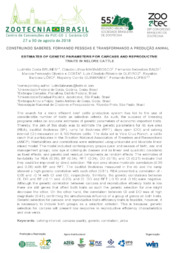Estimates of genetic parameters for carcass and reproductive traits in Nelore cattle.
Estimates of genetic parameters for carcass and reproductive traits in Nelore cattle.
Author(s): BRUNES, L. C.; MAGNABOSCO, C. de U.; BALDI, F. S.; COSTA, M. F. O. e; QUEIROZ, L. C. R. de; LOBO, R. B.; GUIMARAES, N. C.; LOPES, F. B.
Summary: The search for a more efficient beef cattle production system has led to the use of considerable number of traits as selection criteria. As such, the success of breeding programs relies on accurate estimates of genetic parameters of economic important traits. Thereby, the aim of this study was to estimate the genetic parameters for rib eye area (REA), backfat thickness (BF), rump fat thickness (RFT), days open (DO) and calving interval (CI) measured on 4,100 Nelore cattle. The data set is Vera Cruz Ranch, a cattle ranch that participates in the Brazilian National Association of Breeders and Researchers (ANCP). Heritabilities and correlations were estimated using univariate and bivariate linear mixed model. The model included contemporary groups (year and season of birth, sex and management group), cow age at calving (in classes and as linear and quadratic covariate) as fixed effects, and genetic and residual components as random effects. The estimates of heritability for REA (0.38), BF (0.34), RFT (0.34), DO (0.18), and CI (0.21) indicate that they could be improved by direct selection. Rib eye area shows moderate correlation (0.36 and 0.38) with BF and RFT. The backfat thickness measured in the rib and the rump showed a high genetic correlation with each other (0.81). REA presented a correlation of -0.09 and -0.14 with CI and OD, respectively. Similarly, the genetic correlations between CI, DO and BF (-0.11 and -0.20); and CI, DO and RFT (-0.10 and -0.16) were negative. Although the genetic correlation between carcass and reproductive efciency traits is low there are still genes that affect both traits as such the genetic selection for one might decrease the other. On the other hand, the correlation between CI and DO was of high magnitude (0.43), confirming the simultaneous influence of a group of genes on both traits. Genetic selection for carcass and reproductive traits efficiency traits is feasible, however, it is necessary to include both groups as a selection criterion. This is because, genetic selection for carcass will present low response in reproductive efficiency characteristics and vice versa.
Publication year: 2018
Types of publication: Abstract in annals or event proceedings
Unit: Embrapa Cerrados
Keywords: Carcaça, Gado Nelore, Parâmetro Genético, Reprodutor, Reprodução Animal
Observation
Some of Embrapa's publications are published as ePub files. To read them, use or download one of the following free software options to your computer or mobile device. Android: Google Play Books; IOS: iBooks; Windows and Linux: Calibre.
Access other publications
Access the Agricultural Research Database (BDPA) to consult Embrapa's full library collection and records.
Visit Embrapa Bookstore to purchase books and other publications sold by Embrapa.

